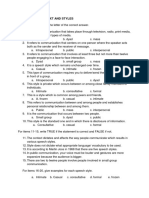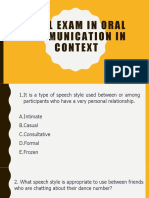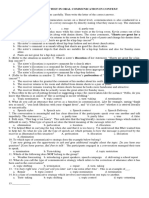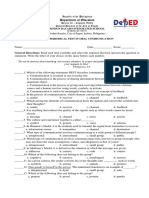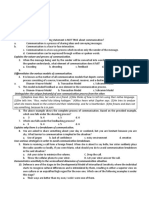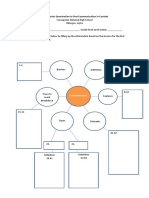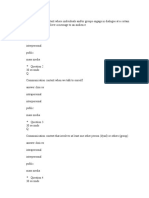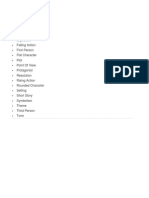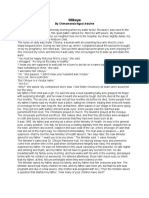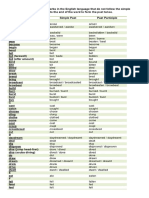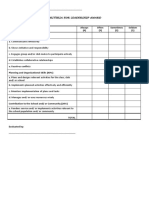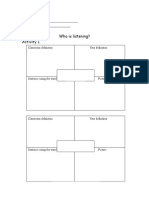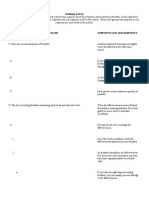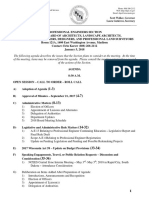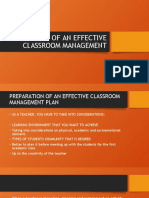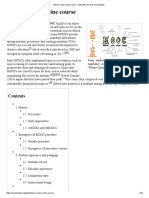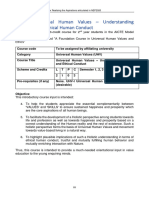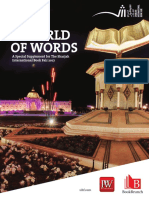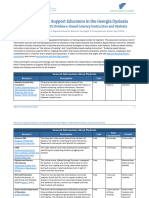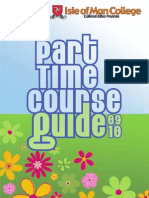Quiz #1 Oral Comm
Quiz #1 Oral Comm
Uploaded by
Mark Alvin Jay CarpioCopyright:
Available Formats
Quiz #1 Oral Comm
Quiz #1 Oral Comm
Uploaded by
Mark Alvin Jay CarpioOriginal Description:
Copyright
Available Formats
Share this document
Did you find this document useful?
Is this content inappropriate?
Copyright:
Available Formats
Quiz #1 Oral Comm
Quiz #1 Oral Comm
Uploaded by
Mark Alvin Jay CarpioCopyright:
Available Formats
Name: _____________________________________________ Date: ____________________
QUIZ #1
Oral Communication in Context
I. ANALOGY. Complete the sets of ideas. Write your answer in blank provided before each number. (5 points)
___________________1. Content : ___________ ; Channel : medium
___________________2. Sender and receiver : communicators ; ___________ :
___________________3. Aristotelian Model; ___________ ; Whites Model: Transactional Model
___________________4. Whites Model: ___________ stages ; Shannon-Weaver Model: five elements
___________________5. Whites Model: cyclical ; Schramms Model : ___________
II. MULTIPLE CHOICE. Choose the letter that corresponds to your answer. Write CAPITAL letters only. (10 points)
___________________1. Robb was talking with Cynthia about a project they have due in class. They were in a crowded restaurant
and were surrounded by parties that were talking loudly. Robb was having a difficult time hearing what Cynthia was saying. What
barrier of communication is manifested in this situation?
A. Perceptual Barrier C. Physical Barrier
B. Emotional Barrier D. Language Barrier
___________________2. What do we call the interaction between a limited number of people, usually two, for the purpose of sharing
information, achieving a goal or maintaining a relationship is known?
A. Intrapersonal Communication C. Public Communication
B. Interpersonal Communication D. Mass Communication
___________________3. Simon decided to run for public office. He scheduled an interview with a local news reporter to discuss his
platform in an attempt to reach the largest audience possible. His interview was aired on the 6pm news and broadcast on the television
station's web channel. The aired interview is known as what type of communication?
A. Intrapersonal Communication C. Public Communication
B. Interpersonal Communication D. Mass Communication
___________________4. Maria was invited as a speaker in a certain school. Her transmitted message became understandable or
meaningful because of her innate or old knowledge about her message or speech. What characteristic of communication is shown in
this situation?
A. Always result into something C. Contextual
B. Progressive or developmental D. Schemata-driven
___________________5. What Joana knows and feels about her environment stays inside herself. Communication will exist when she
decides to convey these to people around her. What characteristic of communication is manifested in this scenario?
A. Active, powerful, or forceful C. Contextual
B. Does not guarantee an automatic link D. Ethical
III. IDENTIFICATION. Identify what barrier is presented in each of the situations below. Write your answer in blank provided
before each number. (5 points)
___________________1. If you go into a situation thinking that the person you are talking to isnt going to understand or be interested
in what you have to say, you may end up subconsciously sabotaging your effort to make your point. You will employ language that is
sarcastic, dismissive, or even obtuse, thereby alienating your conversational partner.
___________________2. Men and women tend to form their thoughts differently, and this must be taken into account when
communicating. This difference has to do with how the brain of each sex is formed during gestation. In general, men are better at
spatial visualization and abstract concepts such as math, while women excel at language-based thinking and emotional identification.
___________________3. Some people spend their entire lives attempting to overcome a poor self-image or a series of deeply rooted
prejudices about their place in the world. They are unable to form genuine connections with people because they have too many false
perceptions blocking the way.
___________________4. People hardly communicate with others because of their differences in the cumulative deposit of knowledge,
experience, beliefs, values, attitudes, meanings, hierarchies, religion, notions of time, roles, spatial relations, concepts of the universe,
and material objects and possessions acquired by a group of people in the course of generations through individual and group striving.
___________________5. Because of the obscurity of language there is always a possibility of wrong interpretation of the messages.
This barrier is created because of the wrong choice of words, in civil words, the wrong sequence of sentences and frequent repetitions.
IV. APPLICATION. Using the seven (7) elements of communication, illustrate your own model. Explain how your model works.
Utilize the back part of your paper. (15 points)
You might also like
- Midterm Exam in Oral CommunicationDocument3 pagesMidterm Exam in Oral CommunicationSofia Tulabing77% (53)
- Oral Comm Quiz Speech Context and StylesDocument1 pageOral Comm Quiz Speech Context and StylesJasmineJoyVinluanRomero88% (8)
- Sto. Niño National High School: Diagnostic Test in Oral CommunicationDocument4 pagesSto. Niño National High School: Diagnostic Test in Oral CommunicationMercy BolandoNo ratings yet
- FINAL EXAM Exam in Oral CommunicationDocument3 pagesFINAL EXAM Exam in Oral CommunicationSofia Tulabing92% (39)
- Purposive Communication Mid-Term Departmental ExamDocument4 pagesPurposive Communication Mid-Term Departmental ExamFerdinand Pinon90% (21)
- The Arrangements: by Chimamanda Ngozi AdichieDocument10 pagesThe Arrangements: by Chimamanda Ngozi AdichieMark Alvin Jay CarpioNo ratings yet
- Summative Test in Oral Communication in ContextDocument2 pagesSummative Test in Oral Communication in ContextShiarica Mae Neri91% (11)
- OCFINALEXAM2019Document6 pagesOCFINALEXAM2019DA FT100% (1)
- Oral Communication PretestDocument4 pagesOral Communication PretestArnez Jewell Dotillos85% (13)
- San Mateo National High School: I. Matching Type Directions: Circle The Letter of The Correct AnswerDocument5 pagesSan Mateo National High School: I. Matching Type Directions: Circle The Letter of The Correct AnswerHelmer Pascual100% (2)
- Oral Communication - Pretest - Post TestDocument4 pagesOral Communication - Pretest - Post TestFlor SarmientoNo ratings yet
- First Quarter Exam: Grade 11 Oral CommunicationDocument4 pagesFirst Quarter Exam: Grade 11 Oral CommunicationJaycher Bagnol100% (1)
- Midterm Exam Oral Com 1ST QuarterDocument4 pagesMidterm Exam Oral Com 1ST QuarterJam Jam100% (2)
- 1st Periodical ExamDocument3 pages1st Periodical ExamDenjay Belogot BarriosNo ratings yet
- Types of Speech Context Types of Speech ContextDocument4 pagesTypes of Speech Context Types of Speech ContextnorikoNo ratings yet
- First Quarter Exam Oral Communication GR 11Document2 pagesFirst Quarter Exam Oral Communication GR 11Ray PatriarcaNo ratings yet
- Prelims - Oral CommunicationDocument2 pagesPrelims - Oral CommunicationJerome Bautista100% (1)
- Midterm Exam in Oral CommunicationDocument3 pagesMidterm Exam in Oral CommunicationBrielle T. BragaisNo ratings yet
- Oral Communication in Context Midterm ExamDocument2 pagesOral Communication in Context Midterm Examcris ann100% (1)
- Pre-Test Oral CommDocument4 pagesPre-Test Oral Commanon_409285199100% (4)
- Oral Communication in ContextDocument3 pagesOral Communication in Contextrogelyn samilin100% (1)
- FINAL EXAM Exam in Oral CommunicationDocument3 pagesFINAL EXAM Exam in Oral CommunicationSofia Tulabing80% (5)
- Second Grading Periodic Test - OrAL COM - SHS 2016Document3 pagesSecond Grading Periodic Test - OrAL COM - SHS 2016Ariel Nube89% (9)
- FINAL EXAM Exam in Oral CommunicationDocument2 pagesFINAL EXAM Exam in Oral CommunicationCecille HernandoNo ratings yet
- FINAL EXAM in Oral Communication in ContextDocument53 pagesFINAL EXAM in Oral Communication in ContextSouthwill learning center100% (1)
- 1st SUMMATIVE TEST IN ORAL COMDocument2 pages1st SUMMATIVE TEST IN ORAL COMMarilou P. Pacaldo75% (4)
- 1stquarter Exam OralCommDocument3 pages1stquarter Exam OralCommyannie isanan0% (1)
- New Normal Oral COM 1ST Quarter Summative Test 2020-2021Document6 pagesNew Normal Oral COM 1ST Quarter Summative Test 2020-2021CherryGolez100% (1)
- Part I-Instruction: Read Each Statement/ Question Carefully and Encircle The Letter of The Correct AnswerDocument4 pagesPart I-Instruction: Read Each Statement/ Question Carefully and Encircle The Letter of The Correct AnswerMaila Lariosa100% (1)
- I. I. MULTIPLE CHOICE: Choose The Letter of The Correct Answer and Write On The Space ProvidedDocument3 pagesI. I. MULTIPLE CHOICE: Choose The Letter of The Correct Answer and Write On The Space ProvidedMerave Candelaria100% (5)
- FINAL Exam in Oral Communication Grade 11: I-Directions: Choose and Encircle The Letter of The Correct AnswerDocument5 pagesFINAL Exam in Oral Communication Grade 11: I-Directions: Choose and Encircle The Letter of The Correct AnswerDazel Dizon Guma100% (4)
- Summative Test in Oral Communication in ContextDocument2 pagesSummative Test in Oral Communication in ContextAbsquatulate100% (1)
- Summative Test Oral Com Q1Document3 pagesSummative Test Oral Com Q1Baems Ambor100% (2)
- First Quarterly Test in Oral CommunicationDocument4 pagesFirst Quarterly Test in Oral CommunicationGladys Encarnacion100% (1)
- Oral Com 1ST Quarter Summative - New Normal - Ocic1Document6 pagesOral Com 1ST Quarter Summative - New Normal - Ocic1Ruben Rosendal De Asis100% (1)
- First Quarter Examination-Oral Com.Document5 pagesFirst Quarter Examination-Oral Com.Buena Fe ChavezNo ratings yet
- Oral Communication in Context: SHS Midterm ExamDocument8 pagesOral Communication in Context: SHS Midterm ExamAndrei John Bajo Banggoc100% (1)
- Oral Communication First Grading ExamDocument5 pagesOral Communication First Grading ExamChristian Ea100% (1)
- 1st Quarter Exam. ORALDocument4 pages1st Quarter Exam. ORALRolly Bordallo100% (2)
- Oral Communication Final Exam 3Document3 pagesOral Communication Final Exam 3Janice Gacula100% (3)
- Test Questions - Speech Writing ProcessDocument2 pagesTest Questions - Speech Writing Processrosettemuje100% (1)
- Periodical Test Grade 11Document3 pagesPeriodical Test Grade 11BelmerDagdag100% (1)
- First-Quarter-Exam-Oral-Communication-Gr-11 2022Document4 pagesFirst-Quarter-Exam-Oral-Communication-Gr-11 2022Anton Colasi CorulloNo ratings yet
- 1st Summative Test in Oral ComDocument2 pages1st Summative Test in Oral ComMarilou P. Pacaldo82% (28)
- 1long Quiz in Oral ComDocument5 pages1long Quiz in Oral ComCristina Faalam GrumalNo ratings yet
- First Quarter Exam in Oral CommunicationDocument3 pagesFirst Quarter Exam in Oral CommunicationMyline Ejorcadas Real100% (4)
- Oral Comm MidtermDocument3 pagesOral Comm MidtermJunreine LeriaNo ratings yet
- Oral Com. Final TestDocument8 pagesOral Com. Final Testkimbeerlyn doromas100% (2)
- Our Lady of The Pillar College-San Manuel Inc. San Manuel, IsabelaDocument4 pagesOur Lady of The Pillar College-San Manuel Inc. San Manuel, IsabelaHillary Rufino100% (1)
- Summative Test Oral Comm 2Document2 pagesSummative Test Oral Comm 2Shiela Repe82% (22)
- Oral Communication Preliminary ExamDocument1 pageOral Communication Preliminary ExamCris Jean Ventura100% (1)
- Oral Communication Quarter 2-Module 5 Summative Test Grade 11Document2 pagesOral Communication Quarter 2-Module 5 Summative Test Grade 11Bang Vergara Abiog100% (1)
- 1st Periodical Exam Oral Communication in Context With Answer KeyDocument4 pages1st Periodical Exam Oral Communication in Context With Answer KeyMelanie Urot100% (1)
- Oral Comm. Quiz 3 Sy 22-23Document1 pageOral Comm. Quiz 3 Sy 22-23Rholen LumanlanNo ratings yet
- 1st Quarter Examination in Oral Communication in ContextDocument1 page1st Quarter Examination in Oral Communication in ContextRamil Alcantara86% (21)
- Oral Com Quizzes in Speech Style N Speech ContextDocument29 pagesOral Com Quizzes in Speech Style N Speech ContextDhan GregorioNo ratings yet
- 2nd Periodical - Oral Communication Exam 2018-2019Document3 pages2nd Periodical - Oral Communication Exam 2018-2019Ri ElNo ratings yet
- FINAL EXAM Exam in Oral Communication2Document2 pagesFINAL EXAM Exam in Oral Communication2Sofia Tulabing100% (8)
- Second Quarter Summative Test In: A. Speech Context C. Speech Act B. Speech Style D. Communicative StrategiesDocument2 pagesSecond Quarter Summative Test In: A. Speech Context C. Speech Act B. Speech Style D. Communicative StrategiesGinno Osmillo100% (2)
- Our Lady of The Pillar College - San Manuel, Inc. District III, San Manuel, Isa. 1 Quarter ExaminationDocument3 pagesOur Lady of The Pillar College - San Manuel, Inc. District III, San Manuel, Isa. 1 Quarter ExaminationLady Nareth MierdoNo ratings yet
- Oral Communication in ContextDocument3 pagesOral Communication in ContextAr Lou100% (1)
- Word Search Elements of FictionDocument2 pagesWord Search Elements of FictionMark Alvin Jay CarpioNo ratings yet
- Shimenawa: By: Naoko KumagaiDocument3 pagesShimenawa: By: Naoko KumagaiMark Alvin Jay CarpioNo ratings yet
- WordleDocument4 pagesWordleMark Alvin Jay CarpioNo ratings yet
- The Elements of FictionDocument11 pagesThe Elements of FictionMark Alvin Jay Carpio100% (1)
- Olikoye: by Chimamanda Ngozi AdichieDocument3 pagesOlikoye: by Chimamanda Ngozi AdichieMark Alvin Jay CarpioNo ratings yet
- Rubric For Research DefenseDocument1 pageRubric For Research DefenseMark Alvin Jay CarpioNo ratings yet
- Speech # 1: Criterion Excellent (5) Very Satisfactory (4) Satisfactory (3) Needs Improvement (2) ScoreDocument1 pageSpeech # 1: Criterion Excellent (5) Very Satisfactory (4) Satisfactory (3) Needs Improvement (2) ScoreMark Alvin Jay CarpioNo ratings yet
- Rubric For Non-Verbal Communication Group PresentationDocument1 pageRubric For Non-Verbal Communication Group PresentationMark Alvin Jay CarpioNo ratings yet
- Components of A Research PaperDocument6 pagesComponents of A Research PaperMark Alvin Jay CarpioNo ratings yet
- Useful Information About FeasibilityDocument31 pagesUseful Information About FeasibilityMark Alvin Jay CarpioNo ratings yet
- DepEd CriteriaDocument4 pagesDepEd CriteriaMark Alvin Jay CarpioNo ratings yet
- Oral PresentationDocument1 pageOral PresentationMark Alvin Jay CarpioNo ratings yet
- Fashion Show RubricDocument1 pageFashion Show RubricMark Alvin Jay Carpio100% (1)
- Fashion Show RubricDocument1 pageFashion Show RubricMark Alvin Jay Carpio100% (1)
- Forms and Types of Creative NonfictionDocument1 pageForms and Types of Creative NonfictionMark Alvin Jay Carpio93% (14)
- Types of ClaimsDocument2 pagesTypes of ClaimsMark Alvin Jay CarpioNo ratings yet
- Research/Capstone Project RubricDocument4 pagesResearch/Capstone Project RubricMark Alvin Jay CarpioNo ratings yet
- Irregular VerbsDocument15 pagesIrregular VerbsMark Alvin Jay CarpioNo ratings yet
- Speech Rubric RevisedDocument2 pagesSpeech Rubric RevisedMark Alvin Jay CarpioNo ratings yet
- Criteria For Leadership AwardDocument3 pagesCriteria For Leadership AwardMark Alvin Jay CarpioNo ratings yet
- Score Criteria RubricDocument1 pageScore Criteria RubricMark Alvin Jay CarpioNo ratings yet
- PassesDocument5 pagesPassesMark Alvin Jay CarpioNo ratings yet
- Who Is Listening? Activity 1.: Name - PeriodDocument11 pagesWho Is Listening? Activity 1.: Name - PeriodMark Alvin Jay CarpioNo ratings yet
- Outlining ActivityDocument2 pagesOutlining ActivityMark Alvin Jay CarpioNo ratings yet
- Enclosure No. 2 To DM OSDS No.145 S. 2021Document4 pagesEnclosure No. 2 To DM OSDS No.145 S. 2021Lyndyll May C. PatricioNo ratings yet
- Fuller Approach Lesson 82 RPDocument42 pagesFuller Approach Lesson 82 RPRICHELLE DELUSANo ratings yet
- Scott Walker, Governor Laura Gutiérrez, SecretaryDocument36 pagesScott Walker, Governor Laura Gutiérrez, SecretarynitinfutaneNo ratings yet
- 28 Days To Success PDFDocument109 pages28 Days To Success PDFPhạm HuyềnNo ratings yet
- 3) Micro TeachingDocument28 pages3) Micro TeachingHamdy AhmadNo ratings yet
- Tina - LP - Popodoo 4 - B5 - Review All - 07.07.2020Document2 pagesTina - LP - Popodoo 4 - B5 - Review All - 07.07.2020Thảo NguyễnNo ratings yet
- The Anthropology of DidacticsDocument12 pagesThe Anthropology of DidacticsHarnel peñaNo ratings yet
- Chap 8 Planning of An Effective Classroom ManagementDocument12 pagesChap 8 Planning of An Effective Classroom ManagementAfif KimNo ratings yet
- Interpreter and Translator TimesheetDocument1 pageInterpreter and Translator Timesheetleslie.gutierrezNo ratings yet
- Pros 1Document3 pagesPros 1Rosa Palconit100% (2)
- MooocDocument23 pagesMooocAnonymous lNHwbUNo ratings yet
- UHV II SyllabusDocument9 pagesUHV II SyllabusaviadiNo ratings yet
- Maude L. Wyche ScholarshipDocument1 pageMaude L. Wyche Scholarshipbrookrudis42No ratings yet
- Beth Cyr ResumeDocument1 pageBeth Cyr Resumeapi-495220276No ratings yet
- Beginner Guide To Watercolour PaintingDocument20 pagesBeginner Guide To Watercolour Paintinganshika.sawdekarNo ratings yet
- English Club Action PlanDocument2 pagesEnglish Club Action PlanMay-ann Ramos Galliguez ValdezNo ratings yet
- Sharjah Supplement 2017Document24 pagesSharjah Supplement 2017Publishers WeeklyNo ratings yet
- Corporate Social Responsibility of SAIL - INDIA CSRDocument3 pagesCorporate Social Responsibility of SAIL - INDIA CSRSwarup RanjanNo ratings yet
- RapidResponse EvidenceBasedLiteracyInstruction GeorgiaDyslexiaPilotProgram RC6 20-002Document6 pagesRapidResponse EvidenceBasedLiteracyInstruction GeorgiaDyslexiaPilotProgram RC6 20-002acalic1990No ratings yet
- National Seminar On Challenges and Innovative Approaches in Crop Improvement - 2014Document278 pagesNational Seminar On Challenges and Innovative Approaches in Crop Improvement - 2014Senthil Natesan100% (1)
- Bicycle Coalition of Greater Philadelphia Annual Report FY18Document5 pagesBicycle Coalition of Greater Philadelphia Annual Report FY18Bicycle Coalition of Greater PhiladelphiaNo ratings yet
- IOM College PT0910Document34 pagesIOM College PT0910okeefeNo ratings yet
- Mathematics - 9.1Document360 pagesMathematics - 9.1Kireeti Mara100% (1)
- Christine J. Shanks CVDocument4 pagesChristine J. Shanks CVcjshanksNo ratings yet
- VISnwlnRTz6fcKwRTx9g4A M1L1.2 Resource WorkbookDocument52 pagesVISnwlnRTz6fcKwRTx9g4A M1L1.2 Resource Workbookshamant saiNo ratings yet
- English Language Education in Indonesia A Review of Research 2011 2019Document33 pagesEnglish Language Education in Indonesia A Review of Research 2011 2019Elvina ArapahNo ratings yet
- Selection of Learning ExperiencesDocument11 pagesSelection of Learning ExperiencesRiz De Leon Purisima50% (4)
- Structure of A Questionnaire On Children's Attitudes Towards Inclusive Physical Education (Caipe-Cz)Document6 pagesStructure of A Questionnaire On Children's Attitudes Towards Inclusive Physical Education (Caipe-Cz)WanRezawanaWanDaudNo ratings yet
- LMUKA11510 Reliability EngineerDocument4 pagesLMUKA11510 Reliability EngineerInaya GeorgeNo ratings yet
- Employee Empowerment Vijeth A 04119Document96 pagesEmployee Empowerment Vijeth A 04119Charan SangappaNo ratings yet

